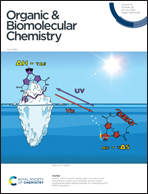Halogen-mediated electrochemical organic synthesis
Abstract
In general, halogenide anions are anodically oxidized into active species, which can be elemental halogen, halogen cations, or halogen radicals. These species subsequently react with substrates, such as olefins, ketones, or amines, to generate halogenated products. We review the mechanisms of these reactions.

- This article is part of the themed collection: Synthetic methodology in OBC


 Please wait while we load your content...
Please wait while we load your content...